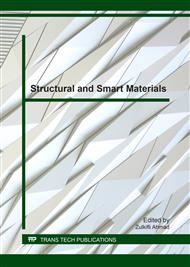[1]
Callus PJ, Mouritz AP, Bannister MK, et al. Tensile properties and failure mechanisms of 3D woven GRP composites[J]. Composites Part A, 1999, 30(11): 1277-1287.
DOI: 10.1016/s1359-835x(99)00033-0
Google Scholar
[2]
Mahadik Y, Hallett SR. Effect of fabric compaction and yarn waviness on 3D woven composite compressive properties[J]. Composites Part A, 2011, 42: 1592-1600.
DOI: 10.1016/j.compositesa.2011.07.006
Google Scholar
[3]
Bakar IAA, Kramer O, Bordas S, et al. Optimization of elastic properties and weaving patterns of woven composites[J]. Composite Structures, 2013, 100: 575-591.
DOI: 10.1016/j.compstruct.2012.12.043
Google Scholar
[4]
Chinese Aeronautical Establishment. Composite material structure design manual[M]. BeiJing: Aviation industry university press, 2001. 11.
Google Scholar
[5]
Whitney JM, Nuismer RJ. Stress fracture criterion for laminated composites containing stress concentration[J]. Journal of Composite Materials, 1974, 8: 253-265.
DOI: 10.1177/002199837400800303
Google Scholar
[6]
Demuts E, Whithead RS, Deo, RB. Assessment of damage tolerance in composites. Composite Structures, 1985, 4(1): 45-58.
DOI: 10.1016/0263-8223(85)90019-4
Google Scholar
[7]
Shen Z, Tang XD, Chen PH. Damage tolerance and durability design of composite aircraft structures[J]. Acta Aeronautica Et Astronautica Sinica, 1991, 12(12): B620-B622.
Google Scholar
[8]
Tang XD, Shen Z, Chen PH Yang SC. Residual strength estimation of composite laminates with damage[J]. Acta Aeronautica Et Astronautica Sinica, 1997, 18(2): 146-152.
Google Scholar
[9]
Soutis C. Damage tolerance of open-hole CFRP laminates loaded in compression[J]. Composites Engineering, 1994, 4(3): 317-327.
DOI: 10.1016/0961-9526(94)90082-5
Google Scholar
[10]
Soutis C, Fleck NA. Static Compression Failure of Carbon Fibre T800/924C Composite Plate with a Single Hole[J]. Journal of composite materials, 1990, 24: 536-558.
DOI: 10.1177/002199839002400505
Google Scholar
[11]
Zhao XF. Impact injury and damage tolerance research on composite stiffened plate. Northwestern Polytechnical University, 2007. 3.
Google Scholar
[12]
Lian W, Yao WX. Residual stiffness-residual strength coupled model of composite laminates[J]. Acta Materiae Compositae Sinica, 2008, 25(5): 151-156.
Google Scholar
[13]
Chamis CC, Minnetyan L. Defect/damage tolerance of pressurized fiber composite shells[J]. Composite Structures, 2001, 51(2): 159-168.
DOI: 10.1016/s0263-8223(00)00141-0
Google Scholar


